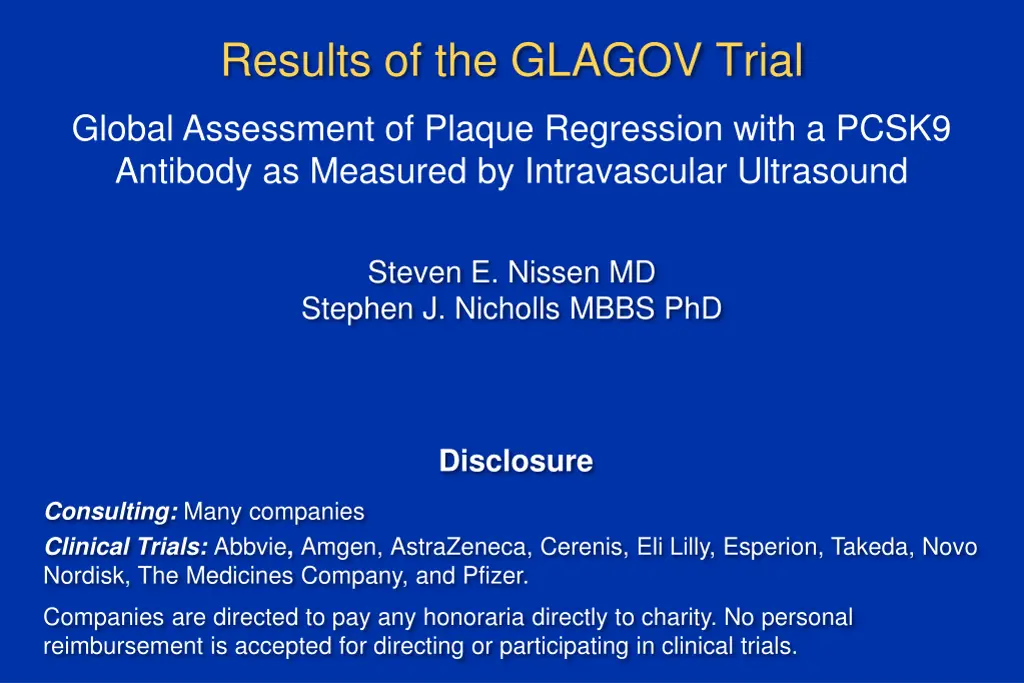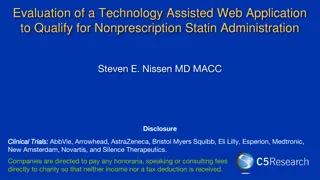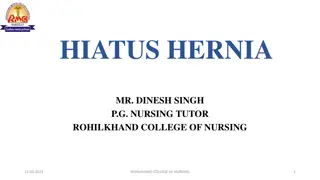
Glagov Trial Results: Plaque Regression with PCSK9 Antibody
Explore the results of the GLAGOV Trial, assessing plaque regression with a PCSK9 antibody as measured by intravascular ultrasound. Led by Steven E. Nissen MD and Stephen J. Nicholls MBBS, this trial involved 968 patients across 197 global centers, focusing on LDL-C reduction and the impact on coronary disease progression. Discover the study design, patient demographics, statin usage, and the percent change in LDL-C during treatment.
Uploaded on | 0 Views
Download Presentation

Please find below an Image/Link to download the presentation.
The content on the website is provided AS IS for your information and personal use only. It may not be sold, licensed, or shared on other websites without obtaining consent from the author. If you encounter any issues during the download, it is possible that the publisher has removed the file from their server.
You are allowed to download the files provided on this website for personal or commercial use, subject to the condition that they are used lawfully. All files are the property of their respective owners.
The content on the website is provided AS IS for your information and personal use only. It may not be sold, licensed, or shared on other websites without obtaining consent from the author.
E N D
Presentation Transcript
Results of the GLAGOV Trial Global Assessment of Plaque Regression with a PCSK9 Antibody as Measured by Intravascular Ultrasound Steven E. Nissen MD Stephen J. Nicholls MBBS PhD Disclosure Consulting: Many companies Clinical Trials:Abbvie, Amgen,AstraZeneca, Cerenis, Eli Lilly, Esperion, Takeda, Novo Nordisk, The Medicines Company, and Pfizer. Companies are directed to pay any honoraria directly to charity. No personal reimbursement is accepted for directing or participating in clinical trials.
Background Prior intravascular ultrasound (IVUS) trials have shown that statins slow progression or induce regression of coronary disease in proportion to the magnitude of LDL-C reduction. No other LDL-lowering therapy has shown regression in an IVUS trial. The lowest LDL-C achieved in prior trials was approximately 60 mg/dL. Effects of lower levels remain unknown. PCSK9 inhibitors incrementally lower LDL-C when added to statins, allowing achievement of very low LDL-C levels, however, no data exist describing effects on progression.
Trial Leadership Steven E. Nissen MD Study Chair Stephen J. Nicholls MBBS PhD Principal Investigator Executive Committee Todd Anderson MD (Canada) Christie Ballantyne MD (Texas) Leslie Cho MD (USA) John Kastelein MD PhD (Netherlands) Wolfgang Koenig MD (Germany) Scott Wasserman MD (USA)* * Sponsor representative
968 patients at 197 global centers with symptomatic CAD and other high risk features. Coronary angiography showing 20-50% stenosis in a target vessel Stable, optimized statin dose for 4 weeks with LDL-C >80 mg/dL or 60-80 mg with additional high risk features Intravascular ultrasound via motorized pullback at 0.5 mm/sec through >40 mm segment Statin Statin plus monthly SC evolocumab 420 mg 18 months treatment monotherapy 61 patients did not complete 61 patients did not complete 423 statin completers 423 evolocumab completers Follow-up IVUS of originally imaged target vessel (n=846)
Baseline Demographics and Statin Usage Characteristic Placebo (N-484) Evolocumab (N=484) Age 59.8 59.8 Male Gender 72.3% 72.1% BMI kg/m2 29.5 29.4 Diabetes 21.5% 20.2% Smoking 23.3% 25.6% Baseline statin use 98.3% 98.8% High intensity 59.9% 57.9% Moderate intensity 38.2% 40.5% Low intensity 0.2% 0.4% Baseline LDL-C 92.4 mg/dL 92.6 mg/dL
Percent Change in LDL-C During Treatment 20 LDL-C Change from Baseline (mg/dL) 10 Mean LDL-C 93.0 mg/dL 0 Change from baseline 3.9% 90 mg/dL -10 -20 -30 -40 -50 Mean LDL-C 36.6 mg/dL -60 Change from baseline -59.8% -70 29 mg/dL -80 0 8 16 24 32 40 48 56 64 72 80 88 Study Week
Primary Endpoint: Percent Atheroma Volume 0.2 0.05 0 P = NS -0.2 Change in Percent Atheroma Volume (%) -0.4 P < 0.0001 -0.6 -0.8 -0.95 -1 P <0.0001 -1.2 Statin Statin- evolocumab monotherapy
Secondary Endpoint: Total Atheroma Volume 0 -0.9 -1 P = NS -2 Change in Total Atheroma Volume (mm3) -3 P < 0.0001 -4 -5 -5.8 -6 P <0.0001 -7 Statin Statin- evolocumab monotherapy
Percent of Patients Showing Regression in PAV Statin Monotherapy Statin plus Evolocumab 100% 100% P <0.0001 for comparison to statin monotherapy group 80% 80% Percentage of Patients (%) Percentage of Patients (%) 64.3% 60% 60% 52.7% 47.3% 35.7% 40% 40% 20% 20% 0% 0% Regressors Progressors Regressors Progressors
Exploratory Subgroup: Baseline LDL-C <70 mg/dL 30 Mean LDL-C 70.6 mg/dL 20 LDL-C Change from Baseline (mg/dL) 10 Change from baseline 16.4% 0 65.5 mg/dL -10 -20 -30 -40 -50 Mean LDL-C 24.0 mg/dL -60 -70 Change from baseline -58.3% -80 15.0 mg/dL -90 0 8 16 24 32 40 48 56 64 72 80 88 Study Week
Exploratory Subgroup: Baseline LDL-C <70 mg/dL Fraction Showing Regression Percent Atheroma Volume 0 100% -0.35 P = NS Percentage Regressing (%) -0.3 81.2% 80% -0.6 Change in PAV (%) -0.9 60% P < 0.0001 48.0% -1.2 40% -1.5 -1.8 -1.97 20% P <0.0001 -2.1 -2.4 0% Statin Statin- evolocumab Statin Statin- evolocumab monotherapy monotherapy
Mean On-Treatment LDL-C vs. Change in PAV Locally Weighted Polynomial Regression (LOESS) Plot with 95% confidence limits Change Percent Atheroma Volume (%) On-Treatment LDL-C (mg/dL)
Interaction: Selected Prespecified Subgroups (PAV) Interaction P value Age < median median -1.09 (-1.61, -0.57) -0.95 (-1.47, -0.43) 0.70 Gender -1.45 (-2.15, -0.76) -0.86 (-1.29, -0.43) Female Male 0.17 Baseline non-HDL < median -1.32 (-1.82, -0.83) median -0.67 (-1.23, -0.11) 0.09 Diabetes -1.32 (-2.10, -0.54) -0.93 (-1.34, -0.51) Yes No 0.39 Statin Intensity -0.86 (-1.33, -0.39) -1.22 (-1.81, -0.62) High Mod/Low 0.36 -2 -1 0 1 2 Favors Evolocumab Favors Placebo
Adverse Clinical Events and Safety Findings Event Placebo (N=484) Evolocumab (N=484) Death Nonfatal MI Nonfatal Stroke Hosp. for Unstable Angina Coronary Revascularization First Major Cardiovascular Event 0.8% 2.9% 0.6% 0.8% 13.6% 15.3% 0.6% 2.1% 0.4% 0.6% 10.3% 12.2% Injection site reactions Anti-evolocumab binding antibody Neutralizing antibodies Neurocognitive events New onset diabetes Myalgia 0% NA NA 1.2% 3.7% 5.8% 0.4% 0.2% 0% 1.4% 3.6% 7.0%
Limitations The GLAGOV trial assessed a select group of patients with coronary disease presenting for a clinically-indicated angiogram treated for only 18 months: Although retention was better than previous IVUS studies, 13% of patients did not have a follow up examination. IVUS is a useful measure of disease activity, but the critical determination of benefit and risk will require completion of large outcomes trials currently underway.
Conclusions-1 In statin-treated patients with symptomatic coronary disease, addition of evolocumab, 420 mg monthly for 18 months: Achieved LDL-C levels averaging 36.6 mg/dL compared with 93 mg/dL for a statin alone. Produced regression, mean change in PAV of -0.95% compared with +0.05% in statin-only patients, (P<0.0001). Induced regression in a greater percentage of patients, 64% vs. 47% (P<.0.0001). Post hoc analysis showed a incremental benefit for combination therapy at LDL-C levels as low as 20 mg/dL
Conclusions-2 Benefits of combination therapy were observed in patients with baseline LDL-C below the lowest levels recommended by global guidelines (<70 mg/dL). No safety issues were identified at the mean LDL-C levels of 36.6 mg/dL achieved in the trial: No excess in new onset diabetes, myalgia, or neurocognitive adverse effects. However, the sample size of the trial was modest, providing limited power for safety assessments.
SJ Nicholls and coauthors Effect of Evolocumab on Progression of Coronary Disease in Statin-Treated Patients: The GLAGOV Randomized Clinical Trial Published online November 15, 2016 Available at jama.com and mobile.jamanetwork.com jamanetwork.com
Some Final Thoughts LDL is now universally accepted as the major driver of atherosclerosis, however, the question of how far to reduce lipid levels has remained a moving target. In medical school, we were taught that a normal total cholesterol was any value <300 mg/dL. Over 4 decades, evidence has accumulated suggesting that optimal LDL-C levels for patients with coronary disease may be much lower than commonly achieved. While we await large outcome trials for PCSK9 inhibitors, the GLAGOV Trial provides intriguing evidence that clinical benefits may extend to LDL-C levels as low as 20 mg/dL.


